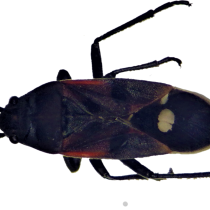
A new scientific contribution has just been made by the Entomology Laboratory of the University of Magellan (UMAG), since, its researchers, Eduardo Faúndez and Mariom Carvajal, in collaboration with Argentine professionals, managed to publish, in the Chilean Journal of Entomology, a work describing a new species for science. These are Lygaeus mauli, from the group of red-breasted bed bugs, which they observed is present in chile’s Aysén Region; and in the Province of Santa Cruz, Argentina.
According to Faúndez, it is the first time that a species of these has been found in southern Patagonia, and is therefore very likely that it is also found in some sectors bordering the Magellan Region. He also commented that as a new taxon, he should have been “baptized”, and, in that quest, linked his name to a well-known character from the film saga “Star Wars” or “Star Wars”: “Darth Maul”.
But what’s it all about? The article states: “Etymology dedicated to the fictional character of the Star Wars saga, Maul (formerly Darth Maul), which has a reddish ornate body like this species. In addition, similarly, as such a fictional character coming from the remote planet Dathomir, this new species is only found in remote areas of southern Patagonia.” In the opinion of the researcher of the Patagonia Institute, “they are names that help increase their visibility, which always favors bringing these kinds of discoveries closer to people”.
Features and differentiation
The work argues that Lygaeus mauli belongs to the family Heteroptera Lygaeidae comprising some 968 species classified in 102 genera (Henry 2009). The species of this group are mainly phytophages; many of them are considered of economic importance, as they attack crops and ornamental plants.
Its authors point out that this species is close to two other bed bugs: Lygaeus alboornatus and Lygaeus froeschneri, but, in distribution, L. mauli is restricted to southern Patagonia (Chile-Argentina), while L. froeschneri is distributed in the highlands, southeastern Peru and Bolivia; and Lygaeus alboornatus, widely available in the Americas (throughout South America and Cuba, Jamaica and the Dominican Republic).
In addition, it differs by characteristics of its internal anatomy, more specifically, genital structures; obtained after various processes including microscopic microdissections and preparations.
In appearance, L. mauli, is also much darker, and this can be explained by the absence of native asclepias (Asclepiadoideae) – better known as “cottons” – in its range, a presumption that seems to be reinforced by the fact that its only known host is a asteraceae, Senecio patagonicus.
Here, they state that Lygaeus species are often associated with asclepias, at least in part of their life cycle, of which they are kidnapped cardenolyids, which makes them unpleasant to some predators, a situation they share with the vast majority of Lygaeinae species. In this way, together with their association with asclepias they have developed aposematic coloration (which present features striking to the senses to alienating their predators), which gives them their characteristic reddish colors.
In this way L. mauli in not receiving these cardenolides is consequently darker, and this could be one of the factors that influenced their differentiation.
Finally, it should be noted that this is the second species of Lygaeus described for both Argentina and Chile.
Possible impact
For the UMAG entomologist, “these kinds of discoveries are not only important because they add native fauna to the area, but also because they are species that need to be kept under observation since, in bed bugs, many species that today are large-scale problems worldwide, lived in their restricted native areas, until, at any given time and for unknown reasons , began to invade different places.”
In this regard, he comments that one example is the brown bedbug marmorada (Halyomorpha halys), which, in only about 30 years has come out from its native area in Asia to invade the United States, Europe, and a few years ago, Chile, “being a big problem for fruit trees,” he said.
In the case of red-red bed bugs (Lygaeus), he noted that while they are associated with asclepias, many of them also, in cases of need, move to other plants including some cultivated, which makes it necessary to monitor them.





